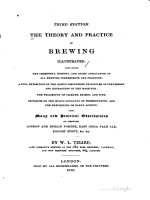- Trang chủ >>
- Y - Dược >>
- Ngoại khoa
oxford handook of urology 3rd ed
Bạn đang xem bản rút gọn của tài liệu. Xem và tải ngay bản đầy đủ của tài liệu tại đây (4.9 MB, 865 trang )
OXFORD MEDICAL PUBLICATIONS
Oxford Handbook of
Urology
Third edition
Published and forthcoming Oxford Handbooks
Oxford Handbook for the
Foundation Programme 3e
Oxford Handbook of Acute
Medicine 3e
Oxford Handbook of Anaesthesia 3e
Oxford Handbook of Applied
Dental Sciences
Oxford Handbook of Cardiology 2e
Oxford Handbook of Clinical and
Laboratory Investigation 3e
Oxford Handbook of Clinical
Dentistry 5e
Oxford Handbook of Clinical
Diagnosis 2e
Oxford Handbook of Clinical
Examination and Practical Skills
Oxford Handbook of Clinical
Haematology 3e
Oxford Handbook of Clinical
Immunology and Allergy 3e
Oxford Handbook of Clinical
Medicine - Mini Edition 8e
Oxford Handbook of Clinical
Medicine 8e
Oxford Handbook of Clinical
Pathology
Oxford Handbook of Clinical
Pharmacy 2e
Oxford Handbook of Clinical
Rehabilitation 2e
Oxford Handbook of Clinical
Specialties 9e
Oxford Handbook of Clinical
Surgery 4e
Oxford Handbook of
Complementary Medicine
Oxford Handbook of Critical Care 3e
Oxford Handbook of Dental Patient
Care 2e
Oxford Handbook of Dialysis 3e
Oxford Handbook of Emergency
Medicine 4e
Oxford Handbook of Endocrinology
and Diabetes 2e
Oxford Handbook of ENT and Head
and Neck Surgery
Oxford Handbook of Epidemiology
for Clinicians
Oxford Handbook of Expedition and
Wilderness Medicine
Oxford Handbook of
Gastroenterology & Hepatology 2e
Oxford Handbook of General
Practice 3e
Oxford Handbook of Genetics
Oxford Handbook of Genitourinary
Medicine, HIV and AIDS 2e
Oxford Handbook of Geriatric
Medicine
Oxford Handbook of Infectious
Diseases and Microbiology
Oxford Handbook of Key Clinical
Evidence
Oxford Handbook of Medical
Dermatology
Oxford Handbook of Medical
Imaging
Oxford Handbook of Medical
Sciences 2e
Oxford Handbook of Medical
Statistics
Oxford Handbook of Nephrology
and Hypertension
Oxford Handbook of Neurology
Oxford Handbook of Nutrition and
Dietetics 2e
Oxford Handbook of Obstetrics and
Gynaecology 2e
Oxford Handbook of Occupational
Health 2e
Oxford Handbook of Oncology 3e
Oxford Handbook of
Ophthalmology 2e
Oxford Handbook of Oral and
Maxillofacial Surgery
Oxford Handbook of Paediatrics 2e
Oxford Handbook of Pain
Management
Oxford Handbook of Palliative
Care 2e
Oxford Handbook of Practical Drug
Therapy 2e
Oxford Handbook of Pre-Hospital
Care
Oxford Handbook of Psychiatry 3e
Oxford Handbook of Public Health
Practice 2e
Oxford Handbook of Reproductive
Medicine & Family Planning
Oxford Handbook of Respiratory
Medicine 2e
Oxford Handbook of
Rheumatology 3e
Oxford Handbook of Sport and
Exercise Medicine
Oxford Handbook of Tropical
Medicine 3e
Oxford Handbook of Urology 3e
1
Oxford Handbook of
Urology
Third edition
John Reynard
Consultant Urological Surgeon
Nuffi eld Department of Surgical Sciences
Oxford University Hospitals
Oxford, UK and
Honorary Consultant Urologist to the
National Spinal Injuries Centre
Stoke Mandeville Hospital
Aylesbury, UK
Simon Brewster
Consultant Urological Surgeon
Nuffi eld Department of Surgical Sciences
Oxford University Hospitals
Oxford, UK
Suzanne Biers
Consultant Urological Surgeon
Addenbrooke’s Hospital
Cambridge University Hospitals
Cambridge, UK
3
Great Clarendon Street, Oxford, OX2 6DP,
United Kingdom
Oxford University Press is a department of the University of Oxford.
It furthers the University’s objective of excellence in research, scholarship,
and education by publishing worldwide. Oxford is a registered trade mark of
Oxford University Press in the UK and in certain other countries
© Oxford University Press, 2013
The moral rights of the author have been asserted
First edition published 2005
Second edition published 2009
Third edition published 2013
All rights reserved. No part of this publication may be reproduced,
stored in a retrieval system, or transmitted, in any form or by any means,
without the prior permission in writing of Oxford University Press,
or as expressly permitted by law, or under terms agreed with the appropriate
reprographics rights organization. Enquiries concerning reproduction
outside the scope of the above should be sent to the Rights Department,
Oxford University Press, at the address above
You must not circulate this book in any other binding or cover and you must
impose the same condition on any acquirer
British Library Cataloguing in Publication Data
Data available
ISBN 978–0–19–969613–0 (fl exicover: alk.paper)
Printed in China by
C&C Offset Printing Co. Ltd.
Oxford University Press makes no representation, express or implied, that the drug
dosages in this book are correct. Readers must therefore always check the product
information and clinical procedures with the most up-to-date published product
information and data sheets provided by the manufacturers and the most recent
codes of conduct and safety regulations. The authors and the publishers do not
accept responsibility or legal liability for any errors in the text or for the misuse or
misapplication of material in this work. Except where otherwise stated, drug
dosages and recommendations are for the non-pregnant adult who is not
breastfeeding.
v
Acknowledgements
The authors would like to express their gratitude to Dr Andrew Protheroe,
medical oncologist at the Churchill Hospital, Oxford, Professor Nick
Watkin, urological surgeon, and Dr Hussain Alnajjar, research fellow, both
at St George’s Hospital, London, for kindly reading and commenting on
parts of the manuscript. They would also like to thank Mr Padraig Malone,
Mr Marcus Drake, and Mr Rowland Rees, who gave freely of their time and
expertise.
This page intentionally left blank
vii
Detailed contents viii
Symbols and Abbreviations xix
1 General principles of management of patients
1
2 Signifi cance and preliminary investigation
of urological symptoms and signs
7
3 Urological investigations
37
4 Bladder outlet obstruction
71
5 Incontinence and female urology
127
6 Infections and infl ammatory conditions
175
7 Urological neoplasia
235
8 Miscellaneous urological disease of the kidney
395
9 Stone disease
427
10 Upper tract obstruction, loin pain, hydronephrosis
491
11 Trauma to the urinary tract and other urological
emergencies
505
12 Infertility
551
13 Sexual health
567
14 Neuropathic bladder
603
15 Urological problems in pregnancy
639
16 Paediatric urology
645
17 Urological surgery and equipment
697
18 Basic science and renal transplant
793
19 Urological eponyms
815
Index 820
Contents
viii
Detailed contents
Symbols and Abbreviations xix
1 General principles of management of patients 1
Communication skills 2
Documentation and note keeping 4
Patient safety in surgical practice 6
2 Signifi cance and preliminary investigation of
urological symptoms and signs 7
Haematuria I: defi nition and types 8
Haematuria II: causes and investigation 10
Haemospermia 14
Lower urinary tract symptoms (LUTS) 16
Nocturia and nocturnal polyuria 18
Loin (fl ank) pain 20
Urinary incontinence 24
Genital symptoms 26
Abdominal examination in urological disease 28
Digital rectal examination (DRE) 30
Lumps in the groin 32
Lumps in the scrotum 34
3 Urological investigations 37
Assessing kidney function 38
Urine examination 40
Urine cytology 42
Prostatic-specifi c antigen (PSA) 43
Radiological imaging of the urinary tract 44
Uses of plain abdominal radiography (the ‘KUB’ X-ray—kidneys,
ureters, bladder) 46
Intravenous urography (IVU) 48
Other urological contrast studies 52
Computed tomography (CT) and magnetic resonance
imaging (MRI) 54
DETAILED CONTENTS
ix
Radioisotope imaging 60
Urofl owmetry 62
Post-void residual urine volume measurement 66
Cystometry, pressure fl ow studies, and videocystometry 68
4 Bladder outlet obstruction 71
Regulation of prostate growth and development of benign
prostatic hyperplasia (BPH) 72
Pathophysiology and causes of bladder outlet obstruction
(BOO) and BPH 73
Benign prostatic obstruction (BPO): symptoms and signs 74
Diagnostic tests in men with LUTS thought to be
due to BPH 76
The management of LUTS in men: NICE 2010 Guidelines 78
Watchful waiting for uncomplicated BPH 84
Medical management of BPH: alpha blockers 86
Medical management of BPH: 5α-reductase inhibitors 88
Medical management of BPH: combination therapy 90
Medical management of BPH: alternative drug therapy 92
Minimally invasive management of BPH: surgical
alternatives to TURP 94
Invasive surgical alternatives to TURP 96
TURP and open prostatectomy 100
Acute urinary retention: defi nition, pathophysiology,
and causes 102
Acute urinary retention: initial and defi nitive management 106
Indications for and technique of urethral catheterization 108
Technique of suprapubic catheterization 110
Management of nocturia and nocturnal polyuria 116
Chronic retention 118
High-pressure chronic retention (HPCR) 120
Bladder outlet obstruction and retention in women 122
Urethral strictures and stenoses 124
5 Incontinence and female urology 127
Incontinence: classifi cation 128
Incontinence: causes and pathophysiology 130
DETAILED CONTENTS
x
Incontinence: evaluation 132
Stress and mixed urinary incontinence 136
Surgery for stress incontinence: injection therapy 138
Surgery for stress incontinence: retropubic suspension 140
Surgery for stress incontinence: suburethral tapes
and slings 142
Surgery for stress incontinence: artifi cial urinary sphincter 146
Overactive bladder: conservative and medical treatments 148
Overactive bladder: options for failed conventional therapy 150
Overactive bladder: intravesical botulinum toxin-A therapy 152
Post-prostatectomy incontinence 154
Vesicovaginal fi stula (VVF) 156
Incontinence in elderly patients 158
Management pathways for urinary incontinence 160
Initial management of urinary incontinence in women 161
Specialized management of urinary incontinence in women 162
Initial management of urinary incontinence in men 163
Specialized management of urinary incontinence in men 163
Management of urinary incontinence in frail older persons 164
Female urethral diverticulum (UD) 166
Pelvic organ prolapse (POP) 170
6 Infections and infl ammatory conditions 175
Urinary tract infection: defi nitions and epidemiology 176
Urinary tract infection: microbiology 178
Lower urinary tract infection: cystitis and investigation
of UTI 182
Urinary tract infection: general treatment guidelines 184
Recurrent urinary tract infection 186
Upper urinary tract infection: acute pyelonephritis 190
Pyonephrosis and perinephric abscess 192
Other forms of pyelonephritis 194
Chronic pyelonephritis 196
Septicaemia 198
Fournier’s gangrene 202
Peri-urethral abscess 204
DETAILED CONTENTS
xi
Epididymitis and orchitis 206
Prostatitis: classifi cation and pathophysiology 208
Bacterial prostatitis 210
Chronic pelvic pain syndrome 212
Bladder pain syndrome (BPS) 214
Urological problems from ketamine misuse 218
Genitourinary tuberculosis 220
Parasitic infections 222
HIV in urological surgery 226
Phimosis 228
Infl ammatory disorders of the penis 230
7 Urological neoplasia 235
Basic pathology and molecular biology 236
Wilms’ tumour and neuroblastoma 238
Radiological assessment of renal masses 242
Benign renal masses 244
Renal cell carcinoma: pathology, staging, and prognosis 246
Renal cell carcinoma: epidemiology and aetiology 250
Renal cell carcinoma: presentation and investigation 252
Renal cell carcinoma (localized): surgical treatment I 254
Renal cell carcinoma: surgical treatment II and non-surgical
alternatives for localized disease 256
Renal cell carcinoma: management of metastatic disease 258
Upper urinary tract transitional cell carcinoma (UUT-TCC) 260
Bladder cancer: epidemiology and aetiology 264
Bladder cancer: pathology, grading, and staging 266
Bladder cancer: clinical presentation 270
Bladder cancer: haematuria, diagnosis, and transurethral resection of
bladder tumour (TURBT) 272
Bladder cancer (non-muscle invasive TCC):
surgery and recurrence 276
Bladder cancer (non-muscle invasive TCC): adjuvant treatment 280
Bladder cancer (muscle-invasive): staging and surgical management
of localized (pT2/3a) disease 282
Bladder cancer (muscle-invasive): radical radiotherapy and palliative
treatment 286
DETAILED CONTENTS
xii
Bladder cancer: management of locally advanced and metastatic
disease 288
Bladder cancer: urinary diversion after cystectomy 290
Prostate cancer: epidemiology and aetiology 294
Prostate cancer: incidence, prevalence, mortality, and survival 296
Prostate cancer: prevention 298
Prostate cancer: pathology of adenocarcinoma 302
Prostate cancer: grading 304
Prostate cancer: staging and imaging 306
Prostate cancer: clinical presentation 315
Prostate cancer: screening 316
Prostate cancer: prostate-specifi c antigen (PSA) 318
Prostate cancer—PSA derivatives and kinetics: free-to-total,
density, velocity, and doubling time 320
Prostate cancer: counselling before PSA testing 322
Prostate cancer: other diagnostic markers 324
Prostate cancer: transrectal ultrasonography and biopsy 326
Prostate cancer: suspicious lesions 330
Prostate cancer: general considerations before treatment
(modifi ed from the 2008 UK NICE Guidance) 331
Prostate cancer: watchful waiting and active surveillance 332
Prostate cancer: radical prostatectomy and pelvic
lymphadenectomy 334
Prostate cancer—radical prostatectomy: post-operative care and
complications 338
Prostate cancer: oncological outcomes of radical prostatectomy 340
Prostate cancer: radical external beam radiotherapy (EBRT) 344
Prostate cancer: brachytherapy (BT) 346
Prostate cancer (minimally invasive management of localized and
radio-recurrent prostate cancer): cryotherapy,
high-intensity focused ultrasound, and photodynamic therapy 348
Prostate cancer: management of locally advanced
non-metastatic disease (T3–4 N0M0) 350
Prostate cancer: management of advanced disease—hormone
therapy I 352
DETAILED CONTENTS
xiii
Prostate cancer: management of advanced disease—hormone
therapy II 354
Prostate cancer: management of advanced disease—hormone
therapy III 356
Prostate cancer: management of advanced disease—
castrate-resistant prostate cancer (CRPC) 358
Prostate cancer: management of advanced disease—
palliative care 362
Urethral cancer 364
Penile neoplasia: benign, viral-related, and premalignant lesions 368
Penile cancer: epidemiology, risk factors, and pathology 370
Penile cancer: clinical management 374
Scrotal and paratesticular tumours 377
Testicular cancer: incidence, mortality, epidemiology,
and aetiology 378
Testicular cancer: pathology and staging 380
Testicular cancer: clinical presentation, investigation, and primary
treatment 384
Testicular cancer: serum markers 386
Testicular cancer: prognostic staging system for metastatic germ
cell tumours (GCT) 388
Testicular cancer: management of non-seminomatous germ
cell tumours (NSGCT) 390
Testicular cancer: management of seminoma, IGCN, and
lymphoma 392
8 Miscellaneous urological disease of the kidney 395
Simple and complex renal cysts 396
Calyceal diverticulum 399
Medullary sponge kidney (MSK) 400
Acquired renal cystic disease (ARCD) 402
Autosomal dominant polycystic kidney disease (ADPKD) 404
Vesicoureteric refl ux in adults 408
Pelviureteric junction obstruction in adults 412
Anomalies of renal fusion and ascent: horseshoe kidney,
ectopic kidney 416
DETAILED CONTENTS
xiv
Anomalies of renal number and rotation: renal agenesis
and malrotation 420
Upper urinary tract duplication 422
9 Stone disease 427
Kidney stones: epidemiology
428
Kidney stones: types and predisposing factors 432
Kidney stones: mechanisms of formation 434
Factors predisposing to specifi c stone types 436
Evaluation of the stone former 440
Kidney stones: presentation and diagnosis 442
Kidney stone treatment options: watchful waiting and
the natural history of stones 444
Stone fragmentation techniques: extracorporeal lithotripsy
(ESWL) 446
Intracorporeal techniques of stone fragmentation 450
Flexible ureteroscopy and laser treatment 454
Kidney stone treatment: percutaneous nephrolithotomy
(PCNL) 456
Kidney stones: open stone surgery 462
Kidney stones: medical therapy (dissolution therapy) 464
Ureteric stones: presentation 466
Ureteric stones: diagnostic radiological imaging 468
Ureteric stones: acute management 470
Ureteric stones: indications for intervention to relieve obstruction
and/or remove the stone 472
Ureteric stone treatment 476
Treatment options for ureteric stones 478
Prevention of calcium oxalate stone formation 482
Bladder stones 486
Management of ureteric stones in pregnancy 488
10 Upper tract obstruction, loin pain, hydronephrosis 491
Hydronephrosis 492
Management of ureteric strictures (other than PUJO) 496
Pathophysiology of urinary tract obstruction 498
DETAILED CONTENTS
xv
Physiology of urine fl ow from kidneys to bladder 499
Ureter innervation 500
Retroperitoneal fi brosis 502
11 Trauma to the urinary tract and other urological
emergencies 505
Initial resuscitation of the traumatized patient
506
Renal trauma: classifi cation, mechanism, grading 508
Renal trauma: clinical and radiological assessment 512
Renal trauma: treatment 516
Ureteric injuries: mechanisms and diagnosis 520
Ureteric injuries: management 522
Pelvic fractures: bladder and ureteric injuries 526
Bladder injuries 532
Posterior urethral injuries in males and urethral injuries
in females 535
Anterior urethral injuries 536
Testicular injuries 540
Penile injuries 542
Torsion of the testis and testicular appendages 544
Paraphimosis 545
Malignant ureteric obstruction 546
Spinal cord and cauda equina compression 548
12 Infertility 551
Male reproductive physiology 552
Aetiology and evaluation of male infertility 554
Investigation of male infertility 556
Oligozoospermia and azoospermia 560
Varicocele 562
Treatment options for male infertility 564
13 Sexual health 567
Physiology of erection and ejaculation 568
Erectile dysfunction: evaluation 572
Erectile dysfunction: treatment 576
DETAILED CONTENTS
xvi
Peyronie’s disease 580
Priapism 584
Retrograde ejaculation 588
Premature ejaculation 590
Other disorders of ejaculation and orgasm 592
Late-onset hypogonadism (LOH) 594
Hypogonadism and male hormone replacement therapy 596
Urethritis 600
Non-specifi c urethritis and urethral syndrome 602
14 Neuropathic bladder 603
Innervation of the lower urinary tract (LUT) 604
The physiology of urine storage and micturition 608
Bladder and sphincter behaviour in the patient with
neurological disease 610
The neuropathic lower urinary tract: clinical consequences
of storage and emptying problems 612
Bladder management techniques for the neuropathic patient 614
Catheters and sheaths and the neuropathic patient 622
Management of incontinence in the neuropathic patient 624
Management of recurrent urinary tract infections (UTIs)
in the neuropathic patient 628
Management of hydronephrosis in the neuropathic patient 630
Bladder dysfunction in multiple sclerosis, Parkinson’s disease, spina
bifi da, after stroke, and in other neurological disease 632
Neuromodulation in neuropathic and non-neuropathic
lower urinary tract dysfunction 636
15 Urological problems in pregnancy 639
Physiological and anatomical changes in the urinary tract 640
Urinary tract infection (UTI) 642
Hydronephrosis of pregnancy 644
16 Paediatric urology 645
Embryology: urinary tract 646
Embryology: genital tract 648
Undescended testes (UDT) 650
DETAILED CONTENTS
xvii
Urinary tract infection (UTI) 654
Antenatal hydronephrosis 658
Vesicoureteric refl ux (VUR) 662
Megaureter 666
Ectopic ureter 668
Ureterocele 670
Pelviureteric junction (PUJ) obstruction 672
Posterior urethral valves (PUV) 674
Cystic kidney disease 676
Hypospadias 678
Disorders of sex development 682
Exstrophy–epispadias complex 688
Primary epispadias 690
Urinary incontinence in children 692
Nocturnal enuresis 694
17 Urological surgery and equipment 697
Preparation of the patient for urological surgery 698
Antibiotic prophylaxis in urological surgery 702
Complications of surgery in general: DVT and PE 706
Fluid balance and the management of shock in the surgical
patient 710
Patient safety in the urology theatre 712
Transurethral resection (TUR) syndrome 713
Catheters and drains in urological surgery 714
Guidewires 720
Irrigating fl uids and techniques of bladder washout 722
JJ stents 724
Lasers in urological surgery 730
Diathermy 732
Sterilization of urological equipment 736
Telescopes and light sources in urological endoscopy 738
Consent: general principles 740
Cystoscopy 742
Transurethral resection of the prostate (TURP) 744
Transurethral resection of bladder tumour (TURBT) 746
DETAILED CONTENTS
xviii
Optical urethrotomy 748
Circumcision 750
Hydrocele and epididymal cyst removal 752
Nesbit’s procedure 754
Vasectomy and vasovasostomy 756
Orchidectomy 758
Urological incisions 760
JJ stent insertion 762
Nephrectomy and nephro-ureterectomy 764
Radical prostatectomy 766
Radical cystectomy 768
Ileal conduit 772
Percutaneous nephrolithotomy (PCNL) 774
Ureteroscopes and ureteroscopy 778
Pyeloplasty 782
Laparoscopic surgery 784
Endoscopic cystolitholapaxy and (open) cystolithotomy 786
Scrotal exploration for torsion and orchidopexy 788
Electromotive drug administration (EMDA) 790
18 Basic science and renal transplant 793
Basic physiology of bladder and urethra 794
Basic renal anatomy 796
Renal physiology: glomerular fi ltration and regulation
of renal blood fl ow 800
Renal physiology: regulation of water balance 802
Renal physiology: regulation of sodium and
potassium excretion 803
Renal physiology: acid–base balance 804
Renal replacement therapy 806
Renal transplant: recipient 808
Renal transplant: donor 810
Transplant surgery and complications 812
19 Urological eponyms 815
Index 820
xix
Symbols and
Abbreviations
® registered trademark
> more than
< less than
ē equal to or greater than
Ĕ equal to or less than
% percent
°C degree Celsius
d decreased
i increased
b cross-reference
7 approximately
α alpha
β beta
AAA abdominal aortic aneurysm
AAOS American Academy of Orthopaedic Surgeons
AAST American Association for the Surgery of Trauma
AAT androgen ablation therapy
ACCP American College of Chest Physicians
ACE angiotensin-converting enzyme
ACh acetylcholine
ACR albumin:creatinine ratio or acute cellular rejection
ACTH adrenocorticotrophic hormone
ADH antidiuretic hormone
ADT androgen deprivation therapy
ADPKD autosomal dominant polycystic kidney disease
AFP alpha-fetoprotein
AHR acute humoral rejection
AI androgen-independent
AID artifi cial insemination donor
AIDS acquired immunodefi ciency syndrome
a.m. ante meridiem (before noon)
AMACR α-methylacyl CoA racemase
AML angiomyolipoma
amp ampere
AMS American Medical Systems
ANP atrial natriuretic peptide
SYMBOLS AND ABBREVIATIONS
xx
a-NVH asymptomatic non-visible haematuria
APD automated peritoneal dialysis
APF antiproliferative factor
5AR 5α-reductase
ARCD acquired renal cystic disease
5ARI 5α-reductase inhibitor
ARPKD autosomal recessive polycystic kidney disease
ART assisted reproductive techniques
AS active surveillance
ASAP atypical small acinar proliferation
ASTRO American Society of Therapeutic Radiation Oncologists
ATG antithymocyte globulin
ATN acute tubular necrosis
ATP adenosine triphosphate
AUA American Urological Association
AUA-SI American Urological Association Symptom Index
AUR acute urinary retention
AUS artifi cial urinary sphincter
AVM arteriovenous malformation
BAUS British Association of Urological Surgeons
BCG bacillus Calmette–Guérin
BCR bulbocavernosus refl ex
bd bis die (twice daily)
bFGF basic fi broblastic growth factor
BHCG beta human chorionic gonadotrophin
BLI beta-lactamase inhibitor
BMI body mass index
BMSFI Brief Male Sexual Function Inventory
BNI bladder neck incision
BOO bladder outlet obstruction
BP blood pressure
BPE benign prostatic enlargement
bPFS biochemical progression-free survival
BPH benign prostatic hyperplasia
BPLND bilateral pelvic lymphadenectomy
BPO benign prostatic obstruction
BPS bladder pain syndrome
BSE bovine spongiform encephalopathy
BT brachytherapy
BTA bladder tumour antigen
BTX-A botulinum toxin-A
SYMBOLS AND ABBREVIATIONS
xxi
BUO bilateral ureteric obstruction
BXO balanitis xerotica obliterans
CAA Civil Aviation Authority
CABG coronary artery bypass graft
CAH congenital adrenal hyperplasia
CAIS complete androgen insensitivity syndrome
cAMP cyclic adenosine monophosphate
CAPD continuous ambulatory peritoneal dialysis
CBAVD complete bilateral absence of vas deferens
CCF congestive cardiac failure
C
Cr
creatinine clearance
CD collecting duct
CEULDCT contrast-enhanced ultra-low dose computed tomography
CFU colony-forming unit
cGMP cyclic guanosine monophosphate
CI confi dence interval
CIRF clinically insignifi cant residual fragment
CJD Creutzfeldt–Jakob disease
CIS carcinoma in situ
CISC clean intermittent self catheterization
CKD chronic kidney disease
cm centimetre
CMV cytomegalovirus
CNI calcineurin inhibitor
CNS central nervous system
CO
2
carbon dioxide
COPD chronic obstructive pulmonary disease
COPUM congenital obstructive posterior urethral membrane
CP chronic prostatitis
CPA cyproterone acetate
CPB chronic painful bladder (syndrome)
CPPS chronic pelvic pain syndrome
CPRE complete primary repair of bladder exstrophy
Cr creatinine
CRF chronic renal failure
CRP C-reactive protein
CRPC castrate-resistant prostate cancer
CSS cancer-specifi c survival
CT computed tomography or collecting tubule
CTPA computerized tomography pulmonary angiography
CTU computed tomography urography
SYMBOLS AND ABBREVIATIONS
xxii
CT-KUB CT of the kidneys, ureters, and bladder
CVA cerebrovascular accident
CXR chest X-ray
Da Dalton
DCT distal convoluted tubule
DE delayed ejaculation
DESD detrusor-external sphincter dyssynergia
DEXA dual-energy X-ray absorptiometry (scan)
DGI disseminated gonococcal infection
DH detrusor hyperrefl exia
DHT dihyrotestosterone
DI diabetes insipidus
DIC disseminated intravascular coagulation
dL decilitre
DMSA dimercapto-succinic acid (renogram)
DMSO dimethyl sulphoxide
DNA deoxyribonucleic acid
DRE digital rectal examination
DSD detrusor sphincter dyssynergia or disorders of sex
development
DVLA Drivers Vehicle Licensing Agency
DVT deep vein thrombosis
EAU European Association of Urology
EBRT external beam radiotherapy
EBV Epstein–Barr virus
ECF extracellular fl uid
ECG electrocardiogram
ED erectile dysfunction
EDTA ethylene diamine tetra-acetic acid
e.g. exempli gratia (for example)
EGF epidermal growth factor
eGFR estimated glomerular fi ltration rate
EHL electrohydraulic lithotripsy
EIA enzyme immunoassay
ELISA enzyme-linked immunosorbant assay
EMDA electromotive drug administration
EMG electromyography
EMU early morning urine
EPLND extended pelvic lymphadenectomy
EPN emphysematous pyelonephritis
EORTC European Organization for Research and Treatment
of Cancer
SYMBOLS AND ABBREVIATIONS
xxiii
EPS expressed prostatic secretions
ER extended release
ESBL extended spectrum B-lactamase
ESR erythrocyte sedimentation rate
ESSIC European Society for the Study of Bladder Pain
Syndrome/Interstitial Cystitis
ESWL extracorporeal shock wave therapy
etc et cetera
FBC full blood count
FGSI Fournier’s gangrene severity index
FNA fi ne needle aspiration
FSH follicle stimulating hormone
ft foot/feet
FVC frequency volume chart
g gram
GA general anaesthetic
GABA G-aminobutyric acid
GAG glycosaminoglycan
GCT germ cell tumour
GFR glomerular fi ltration rate
GI gastrointestinal
GIFT gamete intrafallopian transfer
Gk Greek
GnRH gonadotrophin-releasing hormone
GP general practitioner
GTN glyceryl trinitrate
GU gonococcal urethritis (or genitourinary)
GUM genitourinary medicine
Gy gray
h hour
H
+
hydrogen ion
HAL hexaminolevulinic acid
Hb haemoglobin
HCG human chorionic gonadotrophin
HCO
3
bicarbonate ion
HDR high-dose rate
HIFU high-intensity focused ultrasound
HIF hypoxia-inducible factor
HIV human immunodefi ciency virus
HLA human leucocyte antigen
HMG-CoA 3-hydroxy-3-methyl-glutaryl-CoA reductase
5-HMT 5-hydroxymethyl tolterodine
SYMBOLS AND ABBREVIATIONS
xxiv
HPCR high pressure chronic retention
HPF high-powered fi eld
H
2
O water
HO house offi cer
HoLAP holmium laser ablation of the prostate
HoLEP holmium laser enucleation of the prostate
HoLRP holmium laser resection of the prostate
HPA Health Protection Agency
HPO
4
2–
phosphate ion
H
2
PO
4
–
phosphoric acid
HPV human papilloma virus
HRO high reliability organization
HRP horseradish peroxidise
HTLA human T lymphotropic virus
Hz Hertz
IC intermittent catheterization or interstitial cystitis
ICD implantable cardioverter defi brillator
i.e. id est (that is)
IFIS intraoperative fl oppy iris syndrome
ISC intermittent catheterization
ICF intracellular fl uid
ICS International Continence Society
ICSI intracytoplasmic sperm injection
ICU intensive care unit
IDC indwelling catheter
IDO idiopathic detrusor overactivity
IELT intravaginal ejaculatory latency time
IFN interferon
Ig immunoglobulin
IGCN intratubular germ cell neoplasia
IGF insulin-like growth factor
IIEF International Index of Erectile Function
IL interleukin
ILP interstitial laser prostatectomy
IM intramuscular
INR international normalized ratio
IPC intermittent pneumatic calf compression
IPSS International Prostate Symptom Score
ISC intermittent self-catheterization
ISD intrinsic sphincter defi ciency
ISF interstitial fl uid









